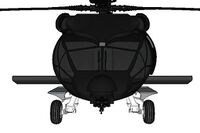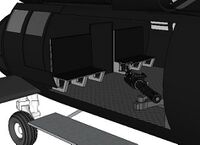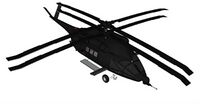UH-45 Valkyrie
UH-45 Valkyrie
The UH-45 Valkyrie is the primary utility, troop transport, and transport rotary helicopter utilized by many branches in the Confederate States Military. Its unique Tandem rotor (dual rotor) design permits the Valkyrie greater stability and lifting capacity than single-rotor designs, allowing it to act in many roles in the Confederate Military, including supply and asset transport.
Description
A medium helicopter for troop transport and cargo delivery, the UH-45 Valkyrie began as a research project for Scion Defense to address the vulnerability of helicopters in an urban combat zone. Over time, however, it evolved into a full blown aircraft development. While outwardly similar to other aircraft in terms of ability the Valkyrie has a few differences that can give it an edge over other helicopters in combat. The most obvious are the coaxial(tandem) rotors. While this is in some ways more maintenance intensive then the standard tail rotor design common to most helicopters, it eliminates a deadly weakness in a combat helicopter and places all the components that give the Valkyrie it's maneuverability at the top of the aircraft within the armoured fuselage, making it harder for ground fire to bring down the aircraft.
The second slightly less obvious change is the repositioning of the door guns from the front of the troop bay, where they are found on most helicopters, to the rear and combined with a mount that allows the gunner to swing the entire weapon outside the aircraft, allowing the gunner to better cover the rear of the aircraft. When combined with the nose's mounted 20mm gun and it's 360 degree fire radius, a vigilant aircrew is able to keep the immediate area clear of RPG toting hostile infantry, while still covering and infantry embarking or disembarking.
The UH-45 Valkyrie was acquired by the Confederate Military to replace the Sikorsky UH-60 Black Hawk Helicopter. It has proven itself in various combat zones across Esvanovia and continues to be used in modern times. It is capable of lifting light transport loads when necessary, but primarily exists to transport troops and supplies across hostile combat zones.
Specifications
General Characteristics
| Feature | Description |
|---|---|
| Cost | 25.3 million |
| Crew | 3-5 (pilot, copilot, flight engineer, and two optional door gunners) |
| Capacity | Up to 14 passengers on seats, plus two door gunners, or up to 3000 kg of cargo split between the troop bay and an external sling load |
| Fuselage Length | 15.2 m |
| Width | 2.13 m |
| Rotor Length | 7.7 m |
| Width with Rotors | 15.4 m |
| Height | 5.2 m |
| Empty Weight | 4,932 kg |
| Max Takeoff Weight | 9,700 kg |
| Power Plant | 2× Scion Industries VUH turbo shafts (1,910 hp each) |
Performance
| Feature | Description |
|---|---|
| Maximum Speed | 326 km/h |
| Cruise Speed | 312 km/h |
| Combat Radius | 512 km |
| Ferry Range | 2,090 km with auxiliary internal and external fuel tanks |
| Service Ceiling | 6,020 m |
| Rate of Climb | 14.1 m/s |
Armament
| Feature | Description |
|---|---|
| Nose Gun | 1× 20mm, three-barreled Gatling gun, mounted on the nose |
| Rear Weapon Mounts | 2× Weapon mounts on the rear of the troop bay (Mounts include 40 and 25mm grenade launchers, Gatling guns, and heavy machine guns) |
| Wing Hardpoints | 2× Hardpoints under each wing, with a third hardpoint on the edges of the wings |



